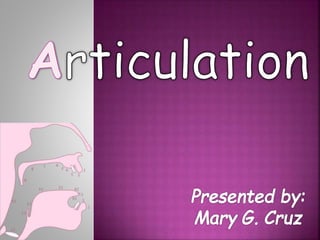Denunciar
Compartir

Recomendados
Recomendados
Más contenido relacionado
La actualidad más candente
La actualidad más candente (20)
Difference between primary and permanent dentition

Difference between primary and permanent dentition
Destacado
Destacado (20)
Anatomy and physiology of oral cavity oropharynx waldeyer’s

Anatomy and physiology of oral cavity oropharynx waldeyer’s
Similar a Oral Physiology
Similar a Oral Physiology (20)
Pyscholinguistics what are speech language disorders

Pyscholinguistics what are speech language disorders
Sounds of language: Phonetics and Applied Linguistics

Sounds of language: Phonetics and Applied Linguistics
INTRODUCTION TO PHONETICE (RAZAN OMAR FLAYFEL).pptx

INTRODUCTION TO PHONETICE (RAZAN OMAR FLAYFEL).pptx
Oral Physiology
- 5. is a process of producing sounds into understandable language
- 7. All languages have voiced and voiceless sounds. Voiced Sounds -Sounds produced when vocal folds come together (adduction) and vibrate Voiceless Sounds -Sounds produced by opening of vocal folds (abduction) and vibration of other parts of mouth and throat
- 9. >Stop >Nasal >Trill >Fricative >Affricative >Approximant >Lateral Approximant -Describes the degree of narrowing in the oral cavity -specify the escape channel, the initiating source of the airflow involved and the certain acoustic or perceptual characteristics.
- 17. Movements and shape changes of the mouth cavity, tongue, and lips produce recognizable vowels and consonants. Vowels -are formed by altering the shape of the lips Consonants -are generated by a movement of the tip of the tongue to and from the back of the teeth or roof of the mouth, or by a rapid separation of the lips.
- 32. Glottal
- 39. Affricative A stop followed by a fricative at the same place of articulation
- 47. Say ‘mmmm’ – where is the ‘m’ sound produced? Pinch your nose – what happens? Put your fingers in your ears – what do you hear?
- 51. Broca's area is one of the main areas of the cerebral cortex responsible for producing language. This brain area controls motor functions involved with speech production. Broca's area is connected to another brain region known as Wernicke’s area. Wernicke's area is associated with processing and understanding language.
- 52. Damage to Broca's Area Damage to Broca's area is called Broca's aphasia. A person suffering damage will likely exhibit problems like words not coming out properly formed, slowed or slurred speech, and prevention of producing words. Damage to Wernicke's area Damage to the Wernicke's area known as Wenicke's aphasia would result in people suffering from the loss of ability to comprehend language, and also the ability to speak words clearly but the inability to properly put them together. The words someone would speak would be out of order and would make no sense.
- 53. Speech-related brain disorders can range from but not limited to strokes, traumatic brain injury, aphasia, brain tumors, brain infections, degeneration defects and disrupted blood flow to the brain. Depending on the extent of the disorder and damage speech can be impaired on different levels. Depending on the disorder and treatment available speech damage may be able to be repaired through speech therapists and ongoing treatment of the disorder.
